Report on Criminological Imagination and Theoretical Perspectives
VerifiedAdded on 2022/12/29
|8
|1913
|68
Report
AI Summary
This report delves into the realm of criminological imagination, focusing on the application of theoretical perspectives, particularly positivism, to understand criminal behavior, especially in children. The report begins with an introduction to criminological imagination and the role of theoretical perspectives in understanding crime from a social perspective. The main body of the report is divided into two parts: the first part identifies and explains the positivism perspective as the relevant theoretical framework for the case scenario of anti-social behavior in children, explaining the reasons for this choice. The second part evaluates the strengths and weaknesses of the positivism perspective, offering a comprehensive analysis. The report concludes with a summary of the findings and provides a list of references used in the research. The report highlights the influence of experiences and knowledge in shaping behavior within the positivism framework, which emphasizes the importance of factual knowledge gained through observation. The report also provides an overview of how this perspective can be used to prevent and treat criminal behavior. The report also contrasts positivism with other perspectives, like classicism, to provide a more comprehensive analysis of the subject matter.
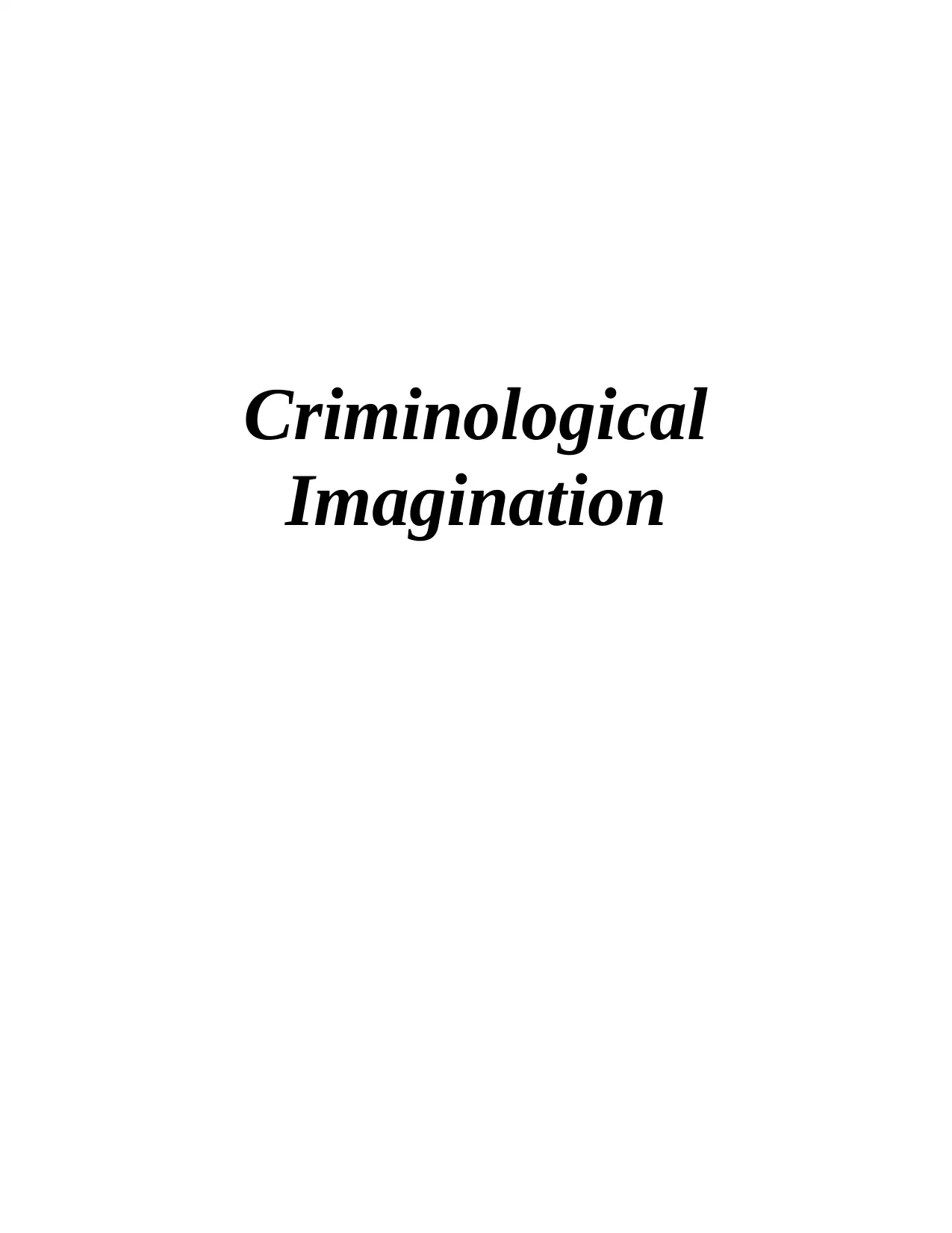
Criminological
Imagination
Imagination
Paraphrase This Document
Need a fresh take? Get an instant paraphrase of this document with our AI Paraphraser
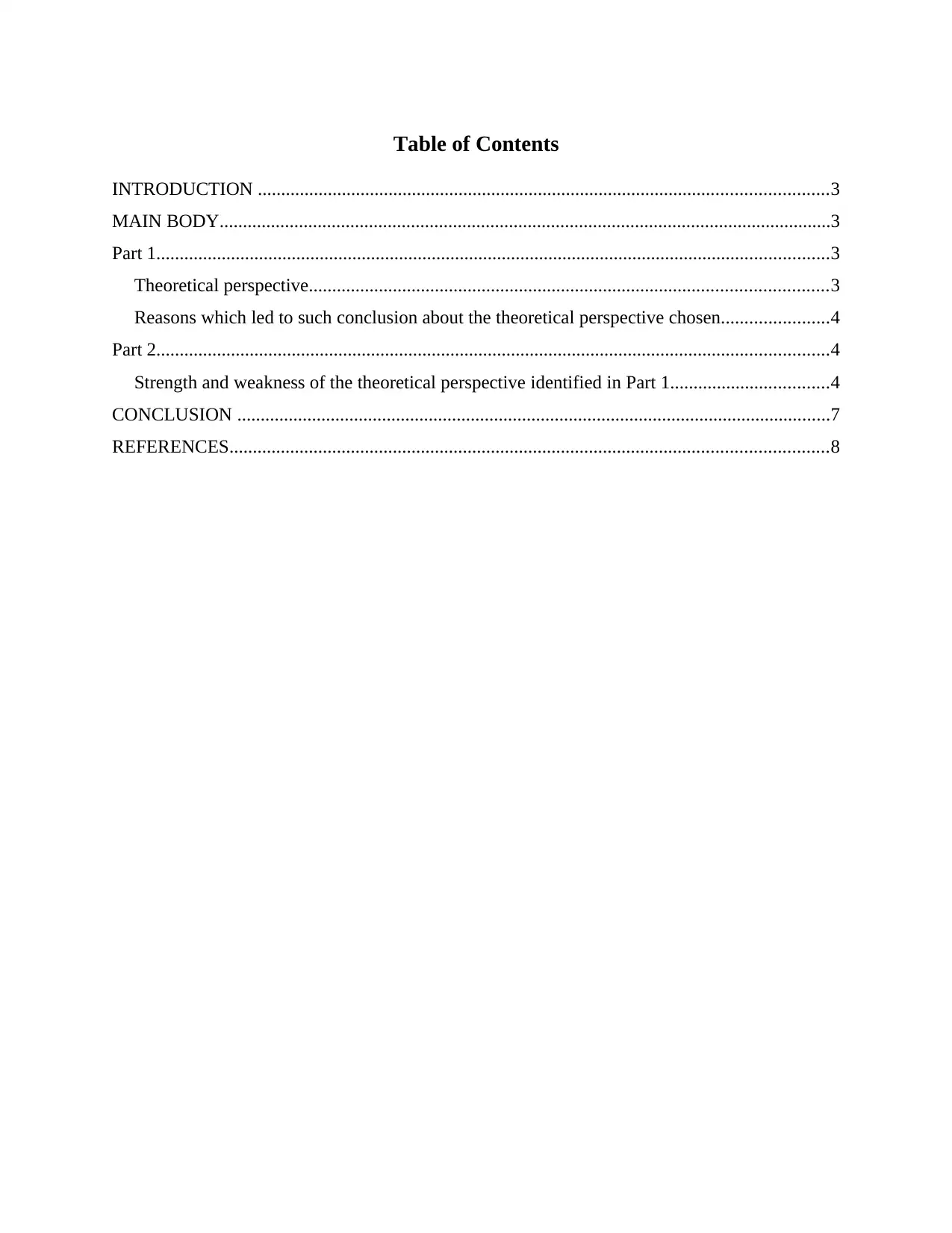
Table of Contents
INTRODUCTION ..........................................................................................................................3
MAIN BODY...................................................................................................................................3
Part 1................................................................................................................................................3
Theoretical perspective...............................................................................................................3
Reasons which led to such conclusion about the theoretical perspective chosen.......................4
Part 2................................................................................................................................................4
Strength and weakness of the theoretical perspective identified in Part 1..................................4
CONCLUSION ...............................................................................................................................7
REFERENCES................................................................................................................................8
INTRODUCTION ..........................................................................................................................3
MAIN BODY...................................................................................................................................3
Part 1................................................................................................................................................3
Theoretical perspective...............................................................................................................3
Reasons which led to such conclusion about the theoretical perspective chosen.......................4
Part 2................................................................................................................................................4
Strength and weakness of the theoretical perspective identified in Part 1..................................4
CONCLUSION ...............................................................................................................................7
REFERENCES................................................................................................................................8
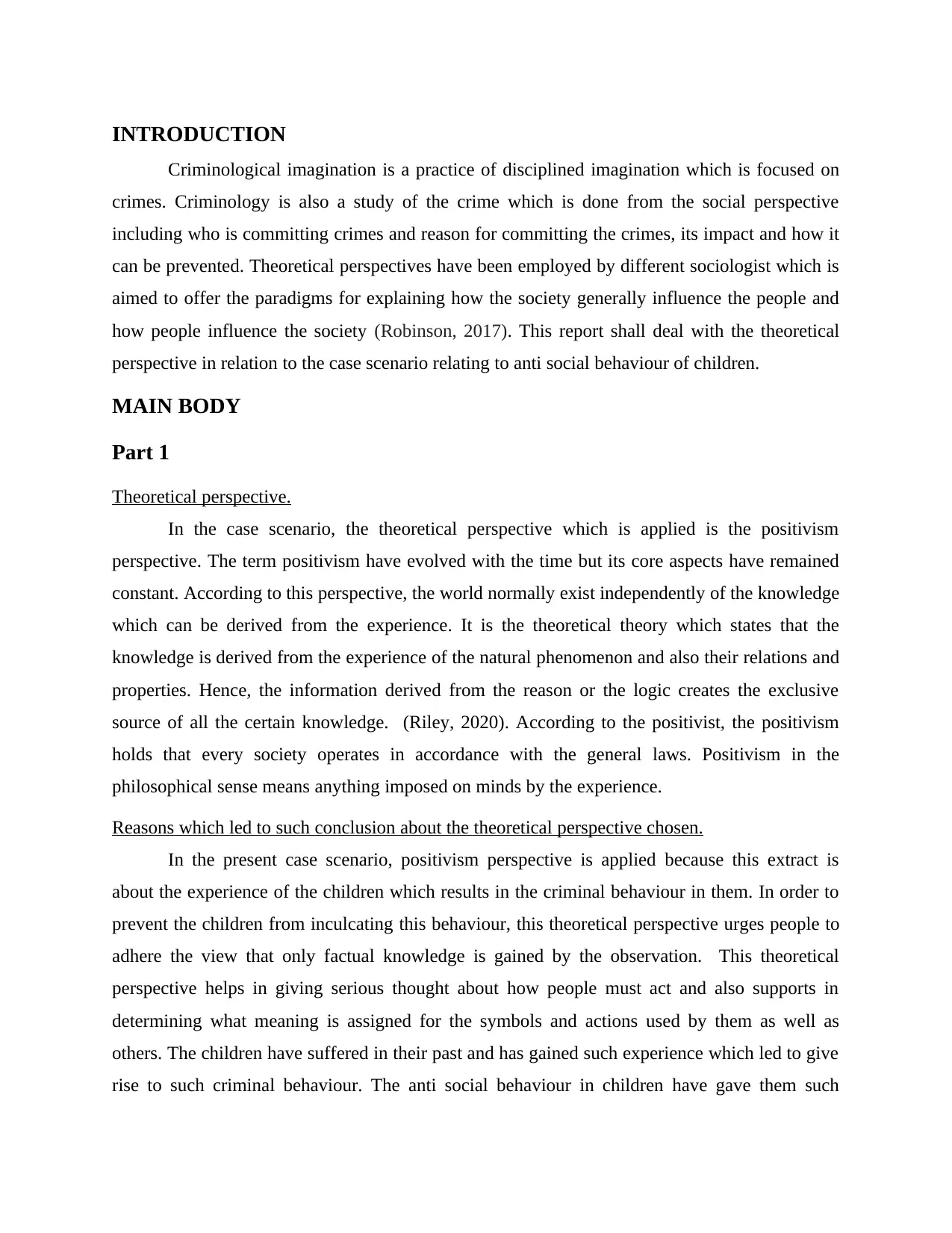
INTRODUCTION
Criminological imagination is a practice of disciplined imagination which is focused on
crimes. Criminology is also a study of the crime which is done from the social perspective
including who is committing crimes and reason for committing the crimes, its impact and how it
can be prevented. Theoretical perspectives have been employed by different sociologist which is
aimed to offer the paradigms for explaining how the society generally influence the people and
how people influence the society (Robinson, 2017). This report shall deal with the theoretical
perspective in relation to the case scenario relating to anti social behaviour of children.
MAIN BODY
Part 1
Theoretical perspective.
In the case scenario, the theoretical perspective which is applied is the positivism
perspective. The term positivism have evolved with the time but its core aspects have remained
constant. According to this perspective, the world normally exist independently of the knowledge
which can be derived from the experience. It is the theoretical theory which states that the
knowledge is derived from the experience of the natural phenomenon and also their relations and
properties. Hence, the information derived from the reason or the logic creates the exclusive
source of all the certain knowledge. (Riley, 2020). According to the positivist, the positivism
holds that every society operates in accordance with the general laws. Positivism in the
philosophical sense means anything imposed on minds by the experience.
Reasons which led to such conclusion about the theoretical perspective chosen.
In the present case scenario, positivism perspective is applied because this extract is
about the experience of the children which results in the criminal behaviour in them. In order to
prevent the children from inculcating this behaviour, this theoretical perspective urges people to
adhere the view that only factual knowledge is gained by the observation. This theoretical
perspective helps in giving serious thought about how people must act and also supports in
determining what meaning is assigned for the symbols and actions used by them as well as
others. The children have suffered in their past and has gained such experience which led to give
rise to such criminal behaviour. The anti social behaviour in children have gave them such
Criminological imagination is a practice of disciplined imagination which is focused on
crimes. Criminology is also a study of the crime which is done from the social perspective
including who is committing crimes and reason for committing the crimes, its impact and how it
can be prevented. Theoretical perspectives have been employed by different sociologist which is
aimed to offer the paradigms for explaining how the society generally influence the people and
how people influence the society (Robinson, 2017). This report shall deal with the theoretical
perspective in relation to the case scenario relating to anti social behaviour of children.
MAIN BODY
Part 1
Theoretical perspective.
In the case scenario, the theoretical perspective which is applied is the positivism
perspective. The term positivism have evolved with the time but its core aspects have remained
constant. According to this perspective, the world normally exist independently of the knowledge
which can be derived from the experience. It is the theoretical theory which states that the
knowledge is derived from the experience of the natural phenomenon and also their relations and
properties. Hence, the information derived from the reason or the logic creates the exclusive
source of all the certain knowledge. (Riley, 2020). According to the positivist, the positivism
holds that every society operates in accordance with the general laws. Positivism in the
philosophical sense means anything imposed on minds by the experience.
Reasons which led to such conclusion about the theoretical perspective chosen.
In the present case scenario, positivism perspective is applied because this extract is
about the experience of the children which results in the criminal behaviour in them. In order to
prevent the children from inculcating this behaviour, this theoretical perspective urges people to
adhere the view that only factual knowledge is gained by the observation. This theoretical
perspective helps in giving serious thought about how people must act and also supports in
determining what meaning is assigned for the symbols and actions used by them as well as
others. The children have suffered in their past and has gained such experience which led to give
rise to such criminal behaviour. The anti social behaviour in children have gave them such
⊘ This is a preview!⊘
Do you want full access?
Subscribe today to unlock all pages.

Trusted by 1+ million students worldwide
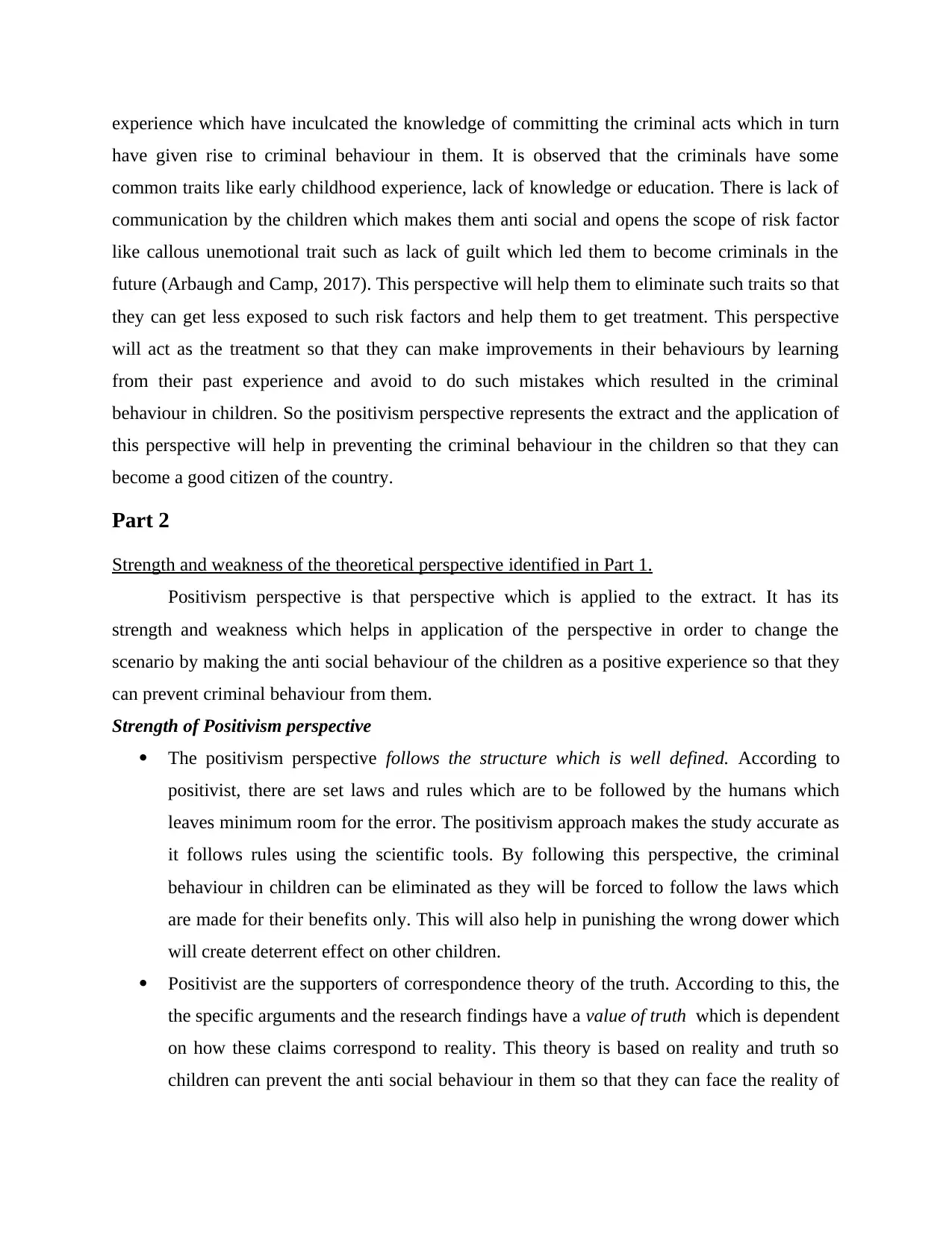
experience which have inculcated the knowledge of committing the criminal acts which in turn
have given rise to criminal behaviour in them. It is observed that the criminals have some
common traits like early childhood experience, lack of knowledge or education. There is lack of
communication by the children which makes them anti social and opens the scope of risk factor
like callous unemotional trait such as lack of guilt which led them to become criminals in the
future (Arbaugh and Camp, 2017). This perspective will help them to eliminate such traits so that
they can get less exposed to such risk factors and help them to get treatment. This perspective
will act as the treatment so that they can make improvements in their behaviours by learning
from their past experience and avoid to do such mistakes which resulted in the criminal
behaviour in children. So the positivism perspective represents the extract and the application of
this perspective will help in preventing the criminal behaviour in the children so that they can
become a good citizen of the country.
Part 2
Strength and weakness of the theoretical perspective identified in Part 1.
Positivism perspective is that perspective which is applied to the extract. It has its
strength and weakness which helps in application of the perspective in order to change the
scenario by making the anti social behaviour of the children as a positive experience so that they
can prevent criminal behaviour from them.
Strength of Positivism perspective
The positivism perspective follows the structure which is well defined. According to
positivist, there are set laws and rules which are to be followed by the humans which
leaves minimum room for the error. The positivism approach makes the study accurate as
it follows rules using the scientific tools. By following this perspective, the criminal
behaviour in children can be eliminated as they will be forced to follow the laws which
are made for their benefits only. This will also help in punishing the wrong dower which
will create deterrent effect on other children.
Positivist are the supporters of correspondence theory of the truth. According to this, the
the specific arguments and the research findings have a value of truth which is dependent
on how these claims correspond to reality. This theory is based on reality and truth so
children can prevent the anti social behaviour in them so that they can face the reality of
have given rise to criminal behaviour in them. It is observed that the criminals have some
common traits like early childhood experience, lack of knowledge or education. There is lack of
communication by the children which makes them anti social and opens the scope of risk factor
like callous unemotional trait such as lack of guilt which led them to become criminals in the
future (Arbaugh and Camp, 2017). This perspective will help them to eliminate such traits so that
they can get less exposed to such risk factors and help them to get treatment. This perspective
will act as the treatment so that they can make improvements in their behaviours by learning
from their past experience and avoid to do such mistakes which resulted in the criminal
behaviour in children. So the positivism perspective represents the extract and the application of
this perspective will help in preventing the criminal behaviour in the children so that they can
become a good citizen of the country.
Part 2
Strength and weakness of the theoretical perspective identified in Part 1.
Positivism perspective is that perspective which is applied to the extract. It has its
strength and weakness which helps in application of the perspective in order to change the
scenario by making the anti social behaviour of the children as a positive experience so that they
can prevent criminal behaviour from them.
Strength of Positivism perspective
The positivism perspective follows the structure which is well defined. According to
positivist, there are set laws and rules which are to be followed by the humans which
leaves minimum room for the error. The positivism approach makes the study accurate as
it follows rules using the scientific tools. By following this perspective, the criminal
behaviour in children can be eliminated as they will be forced to follow the laws which
are made for their benefits only. This will also help in punishing the wrong dower which
will create deterrent effect on other children.
Positivist are the supporters of correspondence theory of the truth. According to this, the
the specific arguments and the research findings have a value of truth which is dependent
on how these claims correspond to reality. This theory is based on reality and truth so
children can prevent the anti social behaviour in them so that they can face the reality of
Paraphrase This Document
Need a fresh take? Get an instant paraphrase of this document with our AI Paraphraser
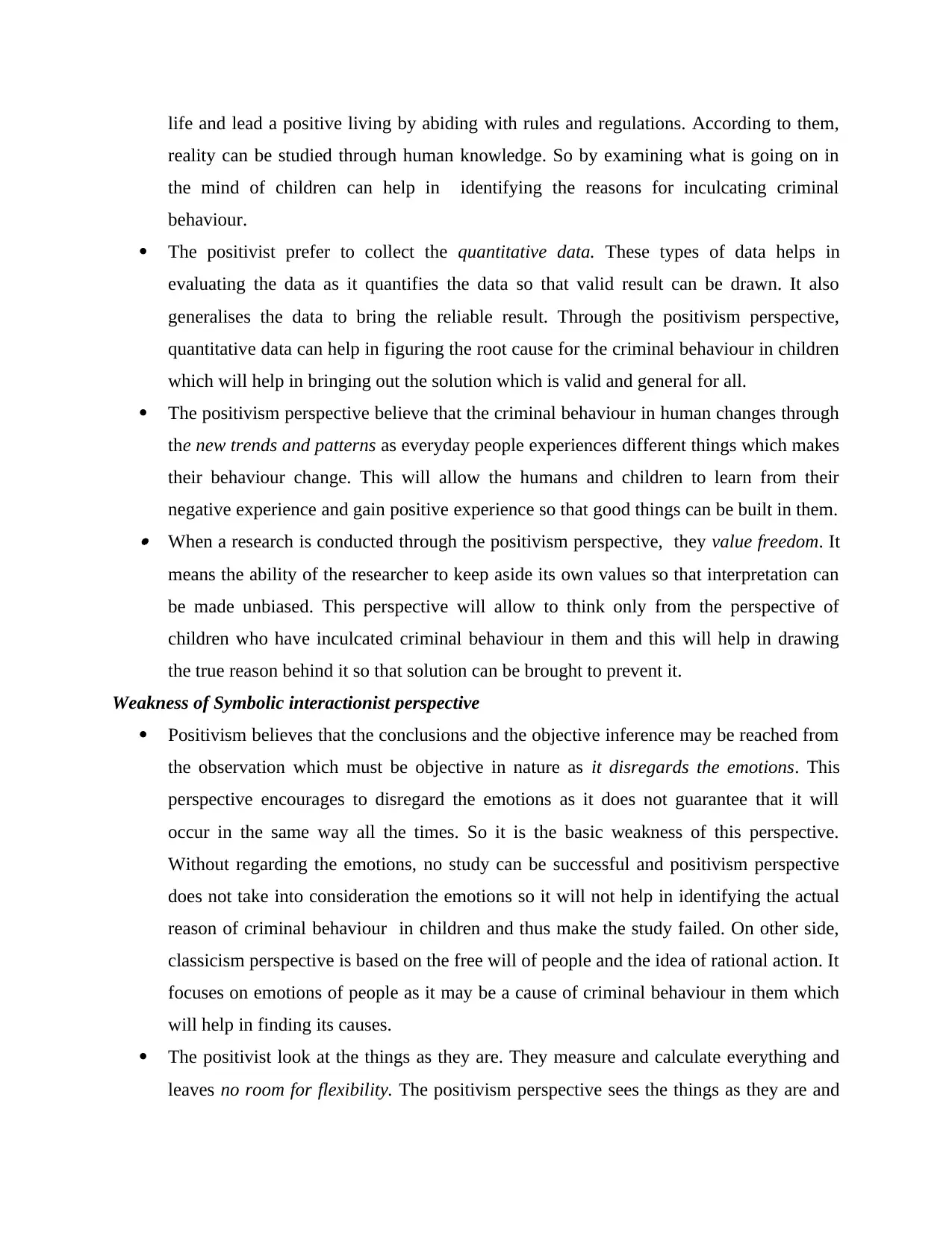
life and lead a positive living by abiding with rules and regulations. According to them,
reality can be studied through human knowledge. So by examining what is going on in
the mind of children can help in identifying the reasons for inculcating criminal
behaviour.
The positivist prefer to collect the quantitative data. These types of data helps in
evaluating the data as it quantifies the data so that valid result can be drawn. It also
generalises the data to bring the reliable result. Through the positivism perspective,
quantitative data can help in figuring the root cause for the criminal behaviour in children
which will help in bringing out the solution which is valid and general for all.
The positivism perspective believe that the criminal behaviour in human changes through
the new trends and patterns as everyday people experiences different things which makes
their behaviour change. This will allow the humans and children to learn from their
negative experience and gain positive experience so that good things can be built in them. When a research is conducted through the positivism perspective, they value freedom. It
means the ability of the researcher to keep aside its own values so that interpretation can
be made unbiased. This perspective will allow to think only from the perspective of
children who have inculcated criminal behaviour in them and this will help in drawing
the true reason behind it so that solution can be brought to prevent it.
Weakness of Symbolic interactionist perspective
Positivism believes that the conclusions and the objective inference may be reached from
the observation which must be objective in nature as it disregards the emotions. This
perspective encourages to disregard the emotions as it does not guarantee that it will
occur in the same way all the times. So it is the basic weakness of this perspective.
Without regarding the emotions, no study can be successful and positivism perspective
does not take into consideration the emotions so it will not help in identifying the actual
reason of criminal behaviour in children and thus make the study failed. On other side,
classicism perspective is based on the free will of people and the idea of rational action. It
focuses on emotions of people as it may be a cause of criminal behaviour in them which
will help in finding its causes.
The positivist look at the things as they are. They measure and calculate everything and
leaves no room for flexibility. The positivism perspective sees the things as they are and
reality can be studied through human knowledge. So by examining what is going on in
the mind of children can help in identifying the reasons for inculcating criminal
behaviour.
The positivist prefer to collect the quantitative data. These types of data helps in
evaluating the data as it quantifies the data so that valid result can be drawn. It also
generalises the data to bring the reliable result. Through the positivism perspective,
quantitative data can help in figuring the root cause for the criminal behaviour in children
which will help in bringing out the solution which is valid and general for all.
The positivism perspective believe that the criminal behaviour in human changes through
the new trends and patterns as everyday people experiences different things which makes
their behaviour change. This will allow the humans and children to learn from their
negative experience and gain positive experience so that good things can be built in them. When a research is conducted through the positivism perspective, they value freedom. It
means the ability of the researcher to keep aside its own values so that interpretation can
be made unbiased. This perspective will allow to think only from the perspective of
children who have inculcated criminal behaviour in them and this will help in drawing
the true reason behind it so that solution can be brought to prevent it.
Weakness of Symbolic interactionist perspective
Positivism believes that the conclusions and the objective inference may be reached from
the observation which must be objective in nature as it disregards the emotions. This
perspective encourages to disregard the emotions as it does not guarantee that it will
occur in the same way all the times. So it is the basic weakness of this perspective.
Without regarding the emotions, no study can be successful and positivism perspective
does not take into consideration the emotions so it will not help in identifying the actual
reason of criminal behaviour in children and thus make the study failed. On other side,
classicism perspective is based on the free will of people and the idea of rational action. It
focuses on emotions of people as it may be a cause of criminal behaviour in them which
will help in finding its causes.
The positivist look at the things as they are. They measure and calculate everything and
leaves no room for flexibility. The positivism perspective sees the things as they are and
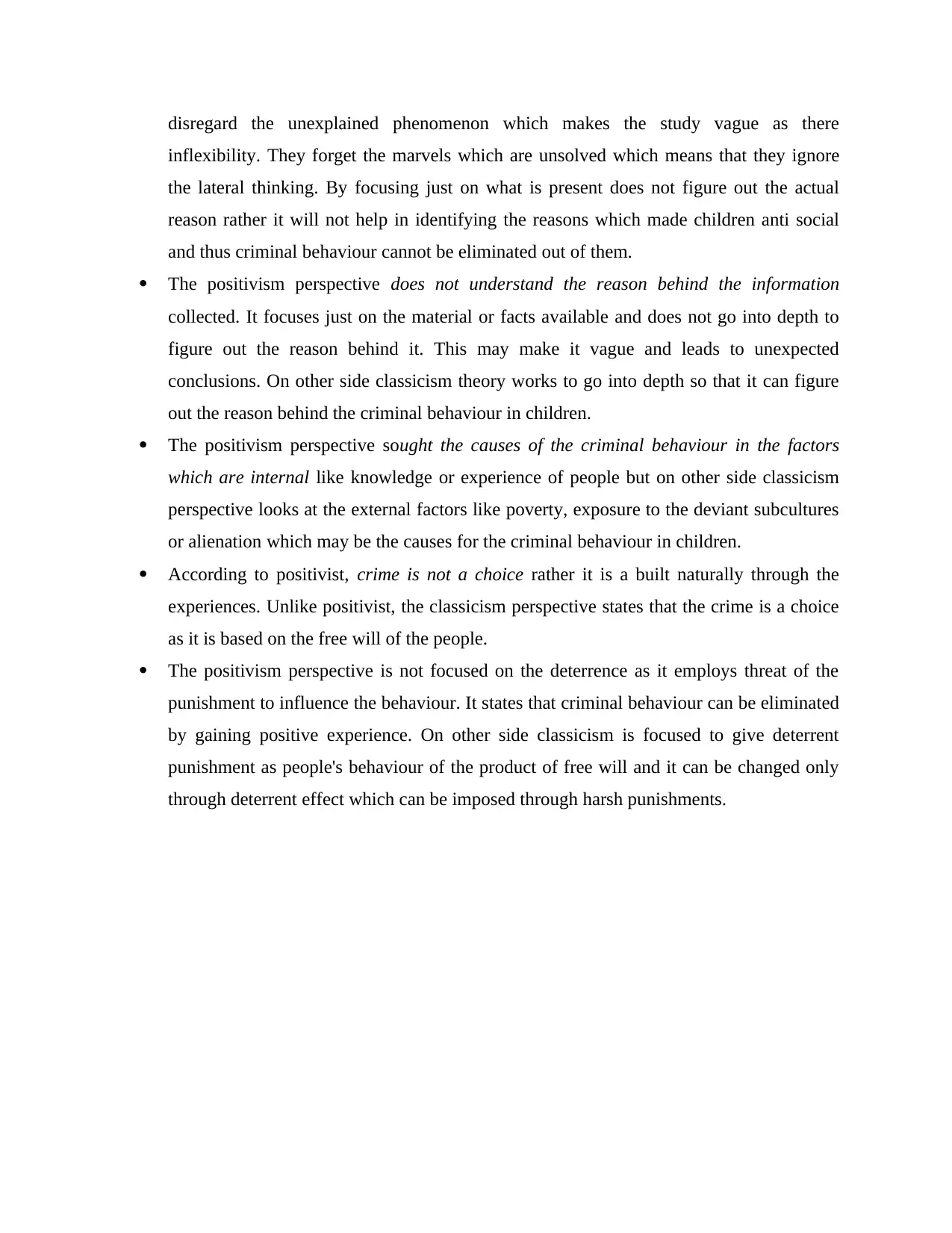
disregard the unexplained phenomenon which makes the study vague as there
inflexibility. They forget the marvels which are unsolved which means that they ignore
the lateral thinking. By focusing just on what is present does not figure out the actual
reason rather it will not help in identifying the reasons which made children anti social
and thus criminal behaviour cannot be eliminated out of them.
The positivism perspective does not understand the reason behind the information
collected. It focuses just on the material or facts available and does not go into depth to
figure out the reason behind it. This may make it vague and leads to unexpected
conclusions. On other side classicism theory works to go into depth so that it can figure
out the reason behind the criminal behaviour in children.
The positivism perspective sought the causes of the criminal behaviour in the factors
which are internal like knowledge or experience of people but on other side classicism
perspective looks at the external factors like poverty, exposure to the deviant subcultures
or alienation which may be the causes for the criminal behaviour in children.
According to positivist, crime is not a choice rather it is a built naturally through the
experiences. Unlike positivist, the classicism perspective states that the crime is a choice
as it is based on the free will of the people.
The positivism perspective is not focused on the deterrence as it employs threat of the
punishment to influence the behaviour. It states that criminal behaviour can be eliminated
by gaining positive experience. On other side classicism is focused to give deterrent
punishment as people's behaviour of the product of free will and it can be changed only
through deterrent effect which can be imposed through harsh punishments.
inflexibility. They forget the marvels which are unsolved which means that they ignore
the lateral thinking. By focusing just on what is present does not figure out the actual
reason rather it will not help in identifying the reasons which made children anti social
and thus criminal behaviour cannot be eliminated out of them.
The positivism perspective does not understand the reason behind the information
collected. It focuses just on the material or facts available and does not go into depth to
figure out the reason behind it. This may make it vague and leads to unexpected
conclusions. On other side classicism theory works to go into depth so that it can figure
out the reason behind the criminal behaviour in children.
The positivism perspective sought the causes of the criminal behaviour in the factors
which are internal like knowledge or experience of people but on other side classicism
perspective looks at the external factors like poverty, exposure to the deviant subcultures
or alienation which may be the causes for the criminal behaviour in children.
According to positivist, crime is not a choice rather it is a built naturally through the
experiences. Unlike positivist, the classicism perspective states that the crime is a choice
as it is based on the free will of the people.
The positivism perspective is not focused on the deterrence as it employs threat of the
punishment to influence the behaviour. It states that criminal behaviour can be eliminated
by gaining positive experience. On other side classicism is focused to give deterrent
punishment as people's behaviour of the product of free will and it can be changed only
through deterrent effect which can be imposed through harsh punishments.
⊘ This is a preview!⊘
Do you want full access?
Subscribe today to unlock all pages.

Trusted by 1+ million students worldwide
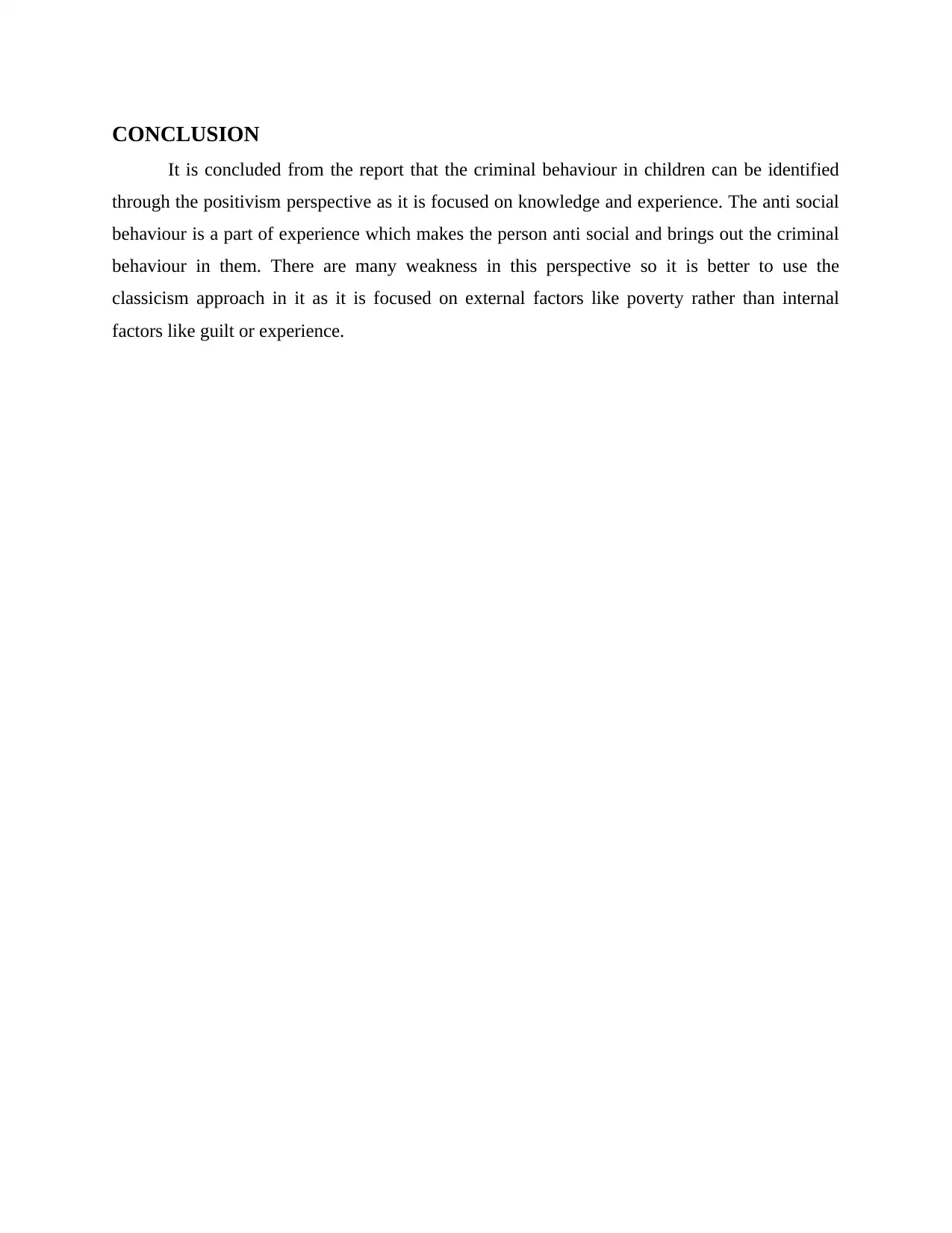
CONCLUSION
It is concluded from the report that the criminal behaviour in children can be identified
through the positivism perspective as it is focused on knowledge and experience. The anti social
behaviour is a part of experience which makes the person anti social and brings out the criminal
behaviour in them. There are many weakness in this perspective so it is better to use the
classicism approach in it as it is focused on external factors like poverty rather than internal
factors like guilt or experience.
It is concluded from the report that the criminal behaviour in children can be identified
through the positivism perspective as it is focused on knowledge and experience. The anti social
behaviour is a part of experience which makes the person anti social and brings out the criminal
behaviour in them. There are many weakness in this perspective so it is better to use the
classicism approach in it as it is focused on external factors like poverty rather than internal
factors like guilt or experience.
Paraphrase This Document
Need a fresh take? Get an instant paraphrase of this document with our AI Paraphraser
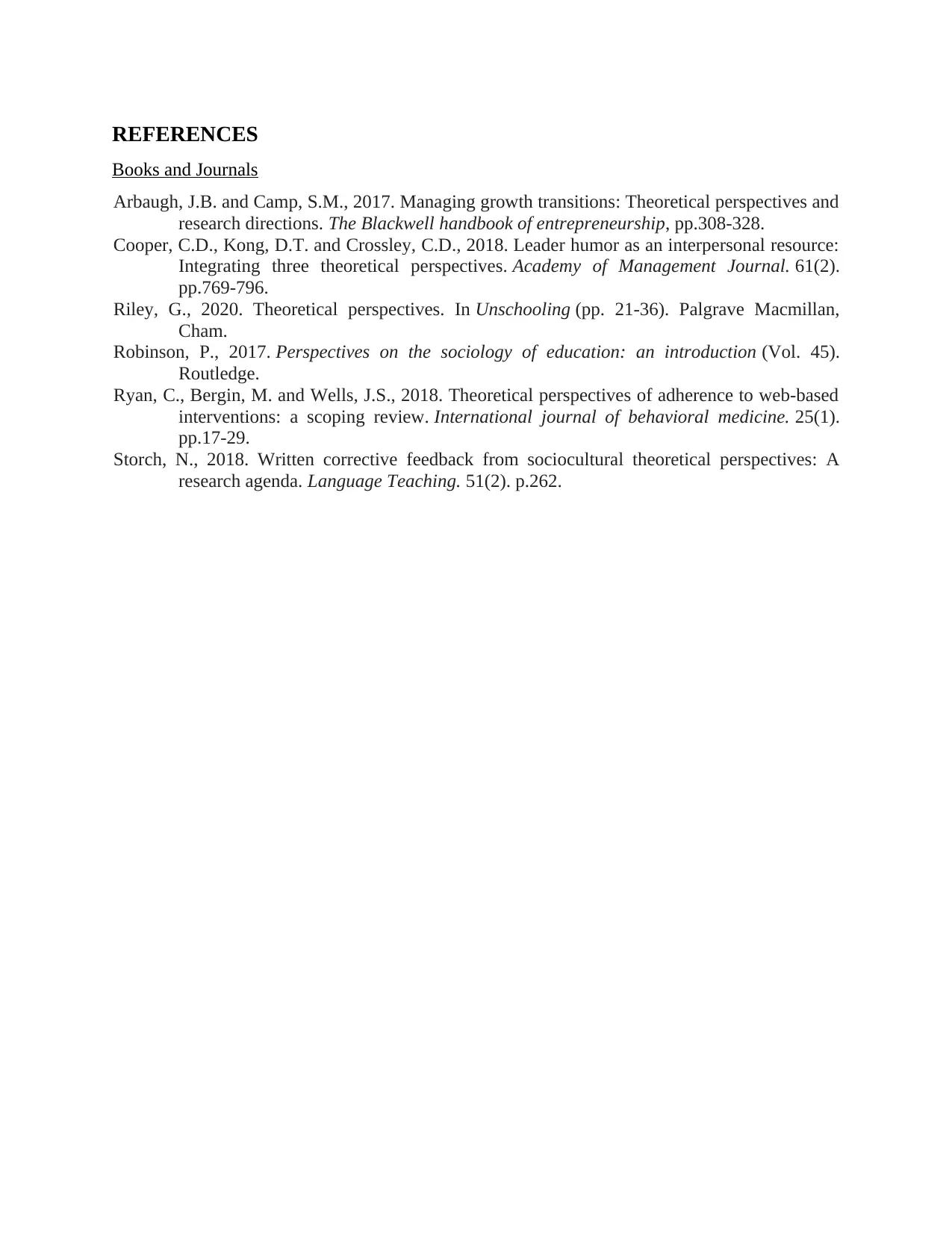
REFERENCES
Books and Journals
Arbaugh, J.B. and Camp, S.M., 2017. Managing growth transitions: Theoretical perspectives and
research directions. The Blackwell handbook of entrepreneurship, pp.308-328.
Cooper, C.D., Kong, D.T. and Crossley, C.D., 2018. Leader humor as an interpersonal resource:
Integrating three theoretical perspectives. Academy of Management Journal. 61(2).
pp.769-796.
Riley, G., 2020. Theoretical perspectives. In Unschooling (pp. 21-36). Palgrave Macmillan,
Cham.
Robinson, P., 2017. Perspectives on the sociology of education: an introduction (Vol. 45).
Routledge.
Ryan, C., Bergin, M. and Wells, J.S., 2018. Theoretical perspectives of adherence to web-based
interventions: a scoping review. International journal of behavioral medicine. 25(1).
pp.17-29.
Storch, N., 2018. Written corrective feedback from sociocultural theoretical perspectives: A
research agenda. Language Teaching. 51(2). p.262.
Books and Journals
Arbaugh, J.B. and Camp, S.M., 2017. Managing growth transitions: Theoretical perspectives and
research directions. The Blackwell handbook of entrepreneurship, pp.308-328.
Cooper, C.D., Kong, D.T. and Crossley, C.D., 2018. Leader humor as an interpersonal resource:
Integrating three theoretical perspectives. Academy of Management Journal. 61(2).
pp.769-796.
Riley, G., 2020. Theoretical perspectives. In Unschooling (pp. 21-36). Palgrave Macmillan,
Cham.
Robinson, P., 2017. Perspectives on the sociology of education: an introduction (Vol. 45).
Routledge.
Ryan, C., Bergin, M. and Wells, J.S., 2018. Theoretical perspectives of adherence to web-based
interventions: a scoping review. International journal of behavioral medicine. 25(1).
pp.17-29.
Storch, N., 2018. Written corrective feedback from sociocultural theoretical perspectives: A
research agenda. Language Teaching. 51(2). p.262.
1 out of 8
Related Documents
Your All-in-One AI-Powered Toolkit for Academic Success.
+13062052269
info@desklib.com
Available 24*7 on WhatsApp / Email
![[object Object]](/_next/static/media/star-bottom.7253800d.svg)
Unlock your academic potential
Copyright © 2020–2025 A2Z Services. All Rights Reserved. Developed and managed by ZUCOL.





